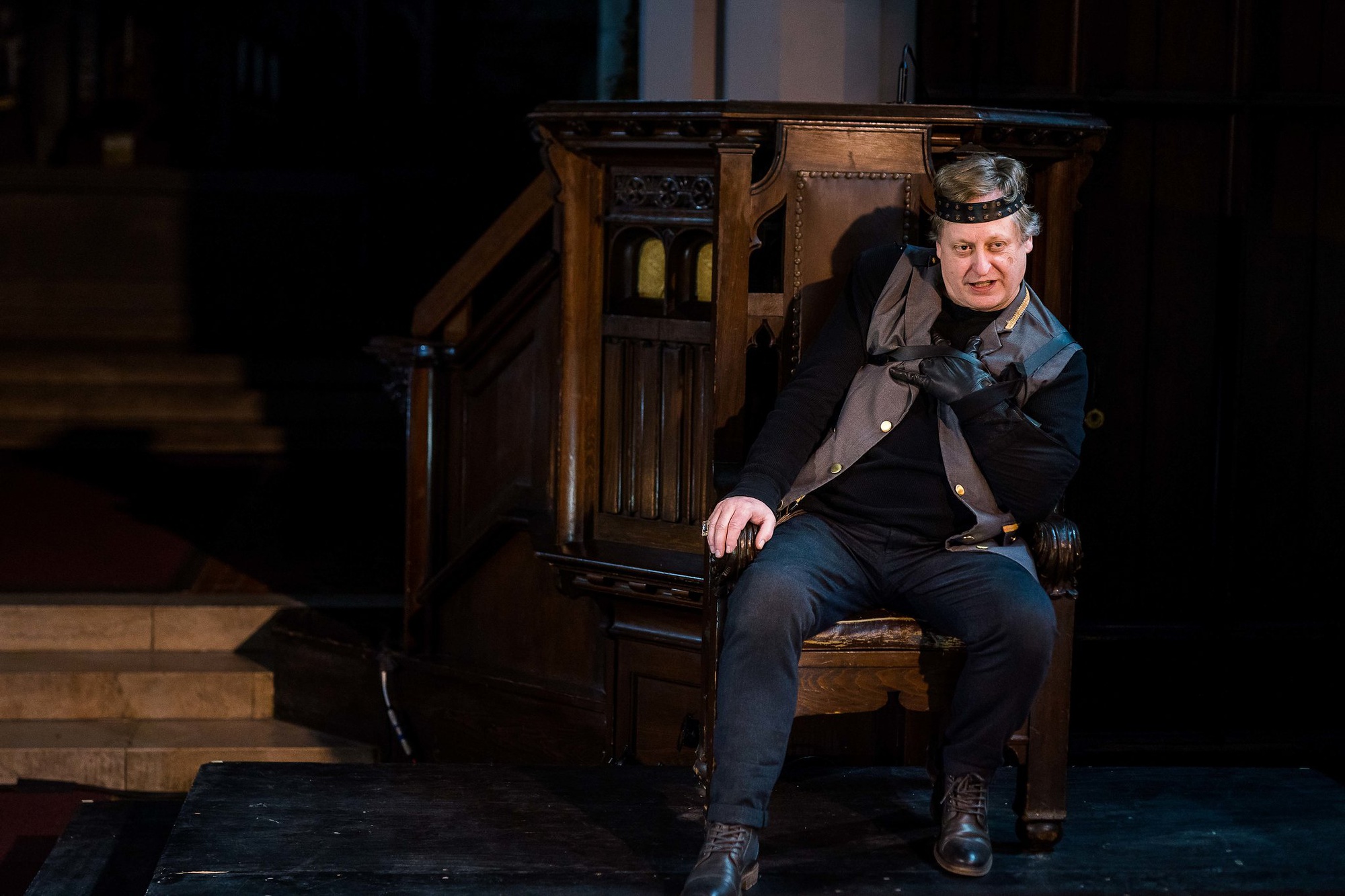
News
Summers Will Not Finish Semester of Teaching as Harvard Investigates Epstein Ties

News
Harvard College Students Report Favoring Divestment from Israel in HUA Survey

News
‘He Should Resign’: Harvard Undergrads Take Hard Line Against Summers Over Epstein Scandal

News
Harvard To Launch New Investigation Into Epstein’s Ties to Summers, Other University Affiliates

News
Harvard Students To Vote on Divestment From Israel in Inaugural HUA Election Survey
'Richard III' Stresses the Humor of the Machiavellian Villain

"Now is the winter of our discontent." When the cast of the Actors’ Shakespeare Project's "Richard III," utters the famed opening line of the titular character's soliloquy, the words bounce off the walls of Swedenborg Chapel in a cascade of echoes. Richard of Gloucester (Steven Barkhimer) enters from the back entrance of the church to finish the rest of the speech, the bright spotlight revealing his arm in a sling and an unmistakable limp in his gait as he walks down the aisle to the front of the chapel. Barkhimer delivers the soliloquy with a rabid fierceness and humor that goes on to characterize the rest of the play.
The production, which runs from Feb. 7 to Mar. 11, is directed by Robert Walsh and stars six actors and actresses, who take on multiple roles in order to cover the numerous parts. The play focuses on the rise of Richard as he schemes to steal the crown away from his brother King Edward (Jennie Israel) and his wife Queen Elizabeth (Paula Plum) during the War of the Roses. First, he orchestrates his second eldest brother George’s murder (Michael Forden Walker), blaming Elizabeth and her York supporters for the tragedy. To secure his claim to the throne, he woos and marries the daughter-in-law of the former King Edward, Anne (Mara Sidmore), and kills his nephews, the heirs to the throne. Over the course of two hours, Richard eliminates obstacle after obstacle through his clever manipulation, but it is not long before his paranoia and guilt lead to his ultimate downfall.
Shakespeare's Richard is a brilliant character, an underdog with a twisted spine, who overcomes his disability and external skepticism to take over the throne. Barkhimer plays the role very eloquently, showing Richard's charming side and stressing his humor. He is particularly moving during the infamous seduction scene, where he convinces a distraught Anne to marry him, despite having killing her husband. His silky words do more than convince her to join his side–they convince the audience. In Act V, Barkhimer nails Richard's paranoia, but fails to induce much pity from the audience at his death after focusing so much on bringing his Machiavellian characteristics to life.
Besides Barkhimer, Jennie Israel, who plays the haunted Queen Margaret, is another standout. She plays Margaret as a haggard, dark madwoman roaming around the chapel cursing her enemies while wielding two yellowed femur bones. The props heighten the witchcraft that Shakespeare imbues in her character, clearly highlighting the unnatural force at work behind the events of this production. She provides a strong contrast to Elizabeth, who Plum plays with begrudging dignity and anger. In the scenes these two actresses share, they thunder with hatred and despair, feelings so clearly present in the script which at times get forgotten. This adaptation understandably eschews these darker emotions in favor of the more comedic aspects of the play, but this choice at times feels slightly overpowering.
The production's use of space and set is another part of what makes it successful. The actors move all over the church throughout the performance, striding through the aisles and bursting out of side doors in a way that truly engrosses the audience into the story. The setting of the play in itself lends to the play's lugubrious ambience, with bright white lights casting chilling shadows across the walls of this small, decorous chapel. The setting also plays up Richard's masquerade as a God-fearing man—the instances when he picks up Bibles from the pews or prays are particularly funny due to the backdrop.
Costume designer Miranda Kau Giurleo and prop designer Abby Shenker keep the play timeless with minimalist, billowing, monochrome outfits and paired down stakes rather than swords. This ensures that the attention focuses on the show, on the plot, and on the speech, rather than on elaborate costumes and props. It also reminds the audience that this takes place during a time of war and unrest where lives are at stake, not simply during the superfluous politics of court life.
Though the production forfeits a certain amount of darkness by stressing its humor, its timelessness and compelling acting make it both enjoyable and accessible. Altogether, it is a solid production, whose set and design elements do much to make it stand out.
—Staff writer Aline G. Damas can be reached at aline.damas@thecrimson.com.
Want to keep up with breaking news? Subscribe to our email newsletter.
